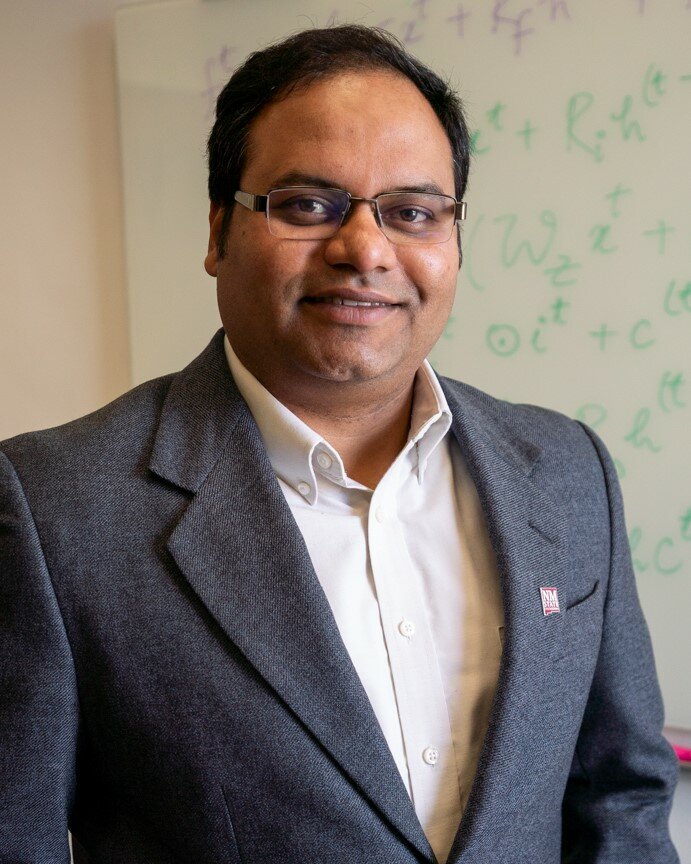
“We are preparing for the grid of the future,” New Mexico State University computer science professor Satyajayant “Jay” Misra said about the research he and 11 Ph.D. students are doing on the Las Cruces campus to modernize and secure the electric grid.
The grid is an interconnected network of producers and consumers that provides electricity to thousands of homes and businesses in Las Cruces and to billions of people worldwide. NMSU is engaged in wide-ranging research to make the grid more efficient and reliable and less vulnerable to disruption and cyberattack, Misra said.
“NMSU has an electric power program with researchers across campus contributing to building the resilient and sustainable grid of the future,” he said.
New Mexico State is helping to create self-sustaining, customer-driven microgrids across the state, Misra said; it is studying the use of brackish water widely available in southern New Mexico to generate hydrogen as a source of renewable energy for the grid; and building grid resilience during weather extremes.
Misra leads the Cybersecurity Resilience Research Group at NMSU, which “is exploring the different dimensions from which malicious actors can adversely impact our critical infrastructure,” he said.
The goal is to prevent phishing and other online attacks on the grid – and on NMSU in general, which is subject to myriad cyber probes every day, Misra said. By studying attacks that have really happened and creating even more serious potential attack scenarios, Misra and his students hope to stay a step ahead of cybercriminals.
“We’re trying to think like them,” Misra said. “You close all the doors and lock them,” he said, create firewalls and “several levels of failsafe,” and keep a close watch for any signs of danger or potential danger.
Misra, his students and other power grid researchers on campus are also working to make the grid more autonomous.
“Many things on the grid still require a human’s intervention,” he said.
That makes a power outage more likely if, for example, a transformer goes down and there is no human on hand to deal with it and no automatic backup in place.
It’s also important to build the grid’s reserve capacity, Misa said, so the electricity is there no matter how large the demand or what the weather is like.
This past July, for example, El Paso Electric (a key NMSU partner in grid modernization) experienced its highest single-demand day in history because of the record-breaking heat.
NMSU wants to help prevent rolling blackouts like the huge one in 2003 that affected an estimated 50 million people in the U.S. and Canada, and the two-day outage earlier this summer that affected more than 40,000 people during 110-degree heat in Phoenix.
That’s where micro-grid technology comes into play, Misra said.
“With smaller, independently operable microgrids, and the integration of renewable energy, there is greater energy availability for everybody and greater resilience,” he said.
Greener technology is an important part of improving the grid, Misra said, including more energy-efficient residential and commercial construction and continuing the move toward all-electric or hybrid vehicles. It also means transitioning the grid from traditional power sources like coal and diesel fuel to wind and solar power, which can be more distributed.
“We do a lot of cool stuff,” Misra said. “We could do more.”
For Misra, “This is a calling. As a teacher and a researcher, I can make a significant difference in somebody’s life,” he said. “My job is to make the world a better place. What drives me is the opportunity to learn about and help fix problems, preparing the next generation to take over while I am doing so. I don’t think it gets any better than that.”
NMSU faculty typically produce more results based on the resources they have available than other universities, he said. “That’s something that makes me proud.”
Misra has a master’s of science degree in information systems and physics from Birla Institute of Technology and Sciences in Rajasthan, India, and a Ph.D. in computer science from Arizona State University. He is a professor in computer science and electrical and computer engineering, the associate dean of research in the NMSU College of Engineering and an affiliated scientist/faculty with Los Alamos National Laboratory. Misra, who joined NMSU in 2009, holds two patents and is the author or co-author of more than 100 papers and book chapters and has been cited more than 8,000 times by his peers.
